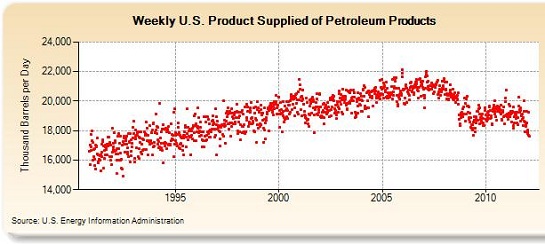Business
See other Business Articles
Title: Index of Leading Economic Indicators in U.S. Climbs 0.4% in Expansion Sign
Source:
Bloomberg
URL Source: http://www.bloomberg.com/news/2012- ... mbs-0-4-in-expansion-sign.html
Published: Feb 17, 2012
Author: Shobhana Chandra
Post Date: 2012-02-17 10:32:51 by Brian S
Keywords: None
Views: 1456
Comments: 1
The index of U.S. leading indicators rose in January for a fourth month, signaling the world’s largest economy will keep expanding through the first half of 2012. The Conference Board’s gauge of the outlook for the next three to six months climbed 0.4 percent after a revised 0.5 percent gain in December that was more than initially reported, the New York-based group said today. The median forecast of economists surveyed by Bloomberg News called for an increase of 0.5 percent. Faster hiring and a jobless rate at a three-year low may encourage more Americans to boost spending, bolstering growth at factories and helping stabilize housing. A strengthening economy means the U.S. will be able to better weather any fallout from the European debt crisis. “The U.S. economic recovery is coming along nicely,” Jennifer Lee, an economist at BMO Capital Markets in Toronto, said before the report. “There are still some headwinds, but the momentum is gradually building up.” Estimates of 48 economists in the Bloomberg survey ranged from gains of 0.4 percent to 1.4 percent. Stocks maintained gains after the figures on optimism Greece will get a bailout. The Standard & Poor’s 500 Index increased 0.2 percent to 1,360.45 at 10:03 a.m. in New York. The yield on the benchmark 10-year Treasury note rose to 2.02 percent from 1.98 percent late yesterday. The cost of living climbed less than forecast in January, another report showed today. The consumer-price index rose 0.2 percent after no change in the prior month, the Labor Department said. Economists projected a 0.3 percent gain, according to the Bloomberg survey median. Seven of the 10 indicators in the leading index contributed to the increase, helped by a gain in the factory workweek and higher stock prices. The Conference Board’s index of coincident indicators, a gauge of current economic activity, rose 0.2 percent after a 0.3 percent gain in the prior month. The coincident index tracks payrolls, incomes, sales and production -- the measures used by the National Bureau of Economic Research to determine the beginning and end of U.S. recessions. The gauge of lagging indicators increased 0.4 percent. Companies seeing a pickup in demand include Swift Transportation Co., the biggest truckload carrier in North America. “Our customers are all doing very, very well,” Jerry Moyes, chief executive officer at Swift Transportation, said in a Feb. 16 conference presentation. “They’re very bullish about going forward. They’re talking about adding new stores, adding new distribution centers and a lot of them have got quite a bit of cash.” Consumers’ moods also are lifting. The Bloomberg Consumer Comfort Index rose for a fourth straight week to reach the highest level in a year as more households said they believe the economy is improving, according to data for the period ended Feb. 12. Claims for jobless benefits last week dropped to the lowest level since 2008, showing the job market is on the mend. Builders began work on more houses in January, and manufacturing in the Philadelphia area accelerated, other reports showed this week. “Despite some recent signs of improvement, the recovery has been frustratingly slow,” Fed Chairman Ben S. Bernanke said yesterday at a news conference. He also said bank supervisors must strike a “delicate balance” between encouraging lending and avoiding a race to the bottom in loan standards. Central bank officials have said they plan to keep the benchmark interest rate low until at least late 2014 to spur economic growth. The Conference Board in January announced changes in the components of the leading index, the first such move since 1996. The group now has its own Leading Credit Index, which aggregates measures of the yield curve, interest-rate swaps and the Fed’s senior loan officer survey. Other changes include revamped measures of new orders and consumer expectations.
Consumer Prices
Increased Confidence
Interest Rates
Post Comment Private Reply Ignore Thread
Top • Page Up • Full Thread • Page Down • Bottom/Latest
#1. To: Brian S (#0)
(Edited)
And volume must be the lowest ever for this time of year. 3.bp.blogspot.com/-krNk9T...0/ceridian%2B2012-01A.png The chart (s) shows the U.S. consumed about 21 million barrels a day (MBD) at the recent peak of economic activity 2005-07; from that peak, "product supplied" has fallen to 18 MBD. The current decline is very steep and has not bottomed. 2nd Law of Thermodynamics: It's impossible to grow using less energy.
helped by higher stock prices


Top • Page Up • Full Thread • Page Down • Bottom/Latest
[Home] [Headlines] [Latest Articles] [Latest Comments] [Post] [Mail] [Sign-in] [Setup] [Help] [Register]
